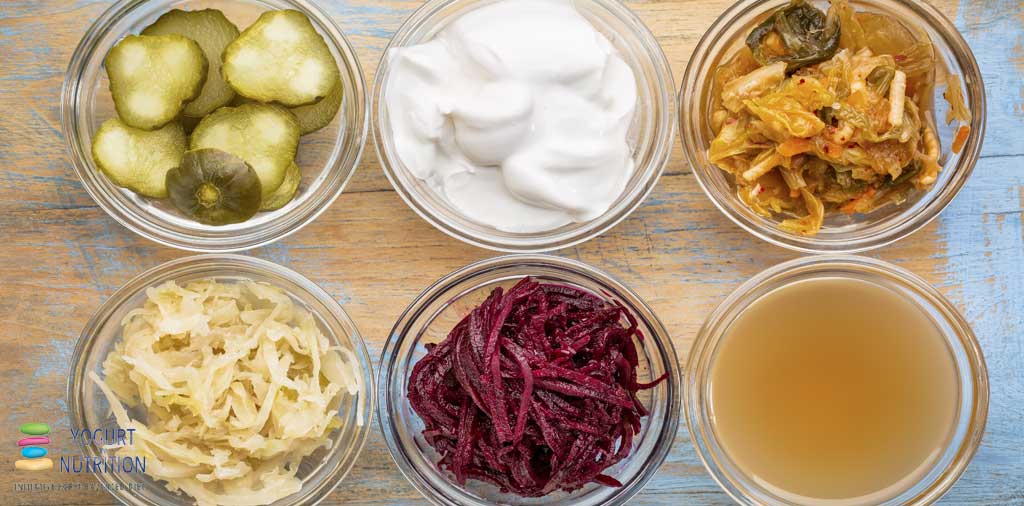Choosing fermented foods such as yogurt can be a great way for us to ingest ‘friendly’ live bacteria that may be associated with health benefits. But not all fermented foods contain live microbes and when they do, the numbers of these tiny life forms can vary hugely between products, say the authors of this article.
Fermentation has long been used to prolong the shelf life of foods and in some cases improve their taste. But more recently we’ve begun to learn about the role fermented foods with live microbes may play in promoting our health.
Many of the microbes found in fermented foods can survive as they travel through the gut to the bowel. Here they mingle with the vast microbe community that naturally inhabits our gut and, even though they’re only passing through, they can modulate this community to give us a healthy boost. Studies have shown the potential health benefits of fermented foods such as yogurt may include lowering the risk of type 2 diabetes and of cardiovascular diseases.
We all know that live yogurt contains loads of these friendly bacteria but we’re generally in the dark when it comes to knowing the actual amounts of live organisms in various different fermented foods – which could be key to determining their health benefits.
Discovering the microbe content of fermented foods
So to find out more, the authors looked at over 140 studies that have calculated the numbers of live organisms in the most commonly consumed fermented foods, mainly those available in our shops. They included fermented foods that are popular in different regions of the world, from cultured dairy products, fermented sausage and vegetables, to soy-based and cereal-based fermented foods.
Results showed that many fermented foods are a good source of live microbes, particularly lactic acid bacteria (LAB) – including species that have been associated with health benefits. However, the number of microbes in fermented foods varied widely according to the type of food, the region it came from, and for how long it had been stored before it was tested.
Fresher products such as yogurt and other cultured dairy products tended to have higher levels of friendly live bacteria than older cheeses, for example.
Yogurts and other dairy products can have high levels of bacteria
All the yogurts in the survey contained the two yogurt culture organisms (Streptococcus thermophilus and Lactobacillus delbrueckii subsp. bulgaricus) at levels ranging from <104 to 109 cfu (colony-forming units, used to estimate viable bacteria) per gram or ml. These levels were similar in frozen yogurt. Where the yogurts were made with additional probiotic bacteria, these were present in counts of up to 108 cfu/g.
A different picture emerged for the chesses, of which over 30 types from 18 countries were surveyed. The highest microbial counts were in Tilsit cheese aged 2–4 months. But Parmesan and Swiss Gruyere, both more than 1 year old, had no detectable microorganisms.
Other fermented products varied widely inn bacterial content
The authors reviewed results from a wide range of other fermented foods from around the world, showing that:
- Fermented pork and beef from several countries varied from having undetectable counts up to high levels – 1010 cfu/g. Fermented sausages in the USA generally had fewer microorganisms than those from European countries where they tend to be made by smaller manufacturers.
- The popular fermented cabbage recipe, sauerkraut, had LAB counts from103 to 108 cfu/g, while olives grown in Europe and the USA contained 104 to 108 cfu/g LAB.
- Similar variations were seen in traditional Asian fermented products such as tempeh and fermented fish.
- Fermented porridges and gruels made with millet or maize and widely eaten in many African countries ranged in their bacterial count from 105 to 109 cfu/g.
- For beer, LAB counts ranged from 102 to 105 cfu/g varying with type and age of the beer.
“Based on the data reported in this survey, consumption of fermented foods would not only provide important macronutrients, they could also deliver large numbers of potentially beneficial microorganisms to the gastrointestinal tract.” – Rezac S et al, 2018.
How many live bacteria do we need?
Few guidelines exist on the numbers of live microorganisms we should be eating to gain a health benefit. The only exception, say the authors, is for yogurt in improving lactose tolerance, for which the European standards require that yogurt should contain at least 108 cfu live starter microorganisms per gram.
Recent research has suggested that we’d need to eat 1010 cells to influence our gut microbiota and provide a potential health benefit. We could achieve this by eating 100 g of fermented food containing 108 cells/g, the authors say. Their results show that this should be possible with several of the fermented products analysed – for example, eating 100 g of yogurt daily, containing 108 cfu/g LAB, would give us our daily target of 1010 microbes.
Some fermented foods have no live organisms
Some foods are made through fermentation but don’t contain live organisms by the time we come to eat them. Bread, some beers and wine, use yeasts for fermentation, but the organisms are killed or removed during production. Such foods may still be able to exert health benefits even without the live microbes, for example, the fermentation may produce vitamins or other bioactive molecules that are not present in the original food.
Fermented foods in dietary guidelines
The authors suggest that fermented foods should be included in dietary guidelines for specific populations, perhaps introducing fermented foods early in childhood as part of the daily diet. Regularly eating fermented foods could also be especially helpful for people in low-income communities that are particularly vulnerable to gut infections, say the authors.
“… several prominent groups have recommended that health care professionals should promote fermented foods containing live microbes as part of public health policy” – Rezac S et al, 2018.



